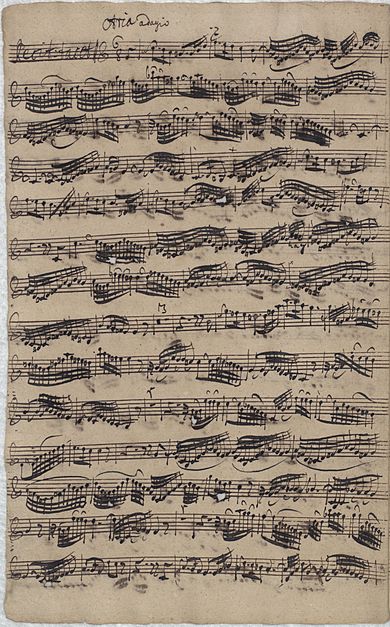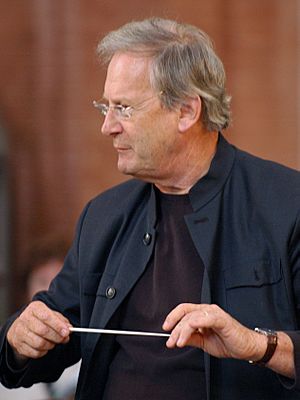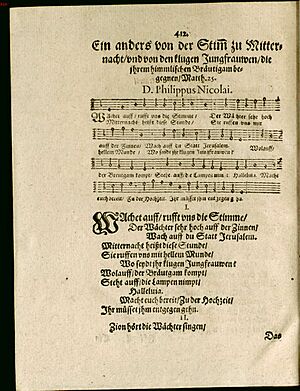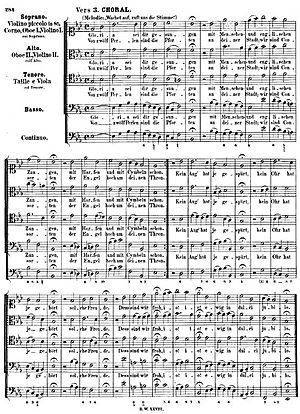Wachet auf, ruft uns die Stimme, BWV 140 facts for kids
Quick facts for kids Wachet auf, ruft uns die Stimme |
|
|---|---|
| Chorale cantata by J. S. Bach | |

Handwritten music for the small violin part of the first soprano-bass song, one of the few instrument parts Bach wrote himself, from the Thomaskirche archives.
|
|
| Other name | Sleepers Wake |
| Occasion | 27th Sunday after Trinity |
| Performed | 25 November 1731: Leipzig |
| Movements | 7 |
| Vocal |
|
| Instrumental |
|
Wachet auf, ruft uns die Stimme (which means 'Awake, the voice calls us'), also known as BWV 140, or Sleepers Wake, is a famous piece of church music by Johann Sebastian Bach. Many people think it is one of his best and most popular works. Bach wrote this cantata in Leipzig for a special church day called the 27th Sunday after Trinity. He first performed it on November 25, 1731.
Bach created this cantata to finish his second series of chorale cantatas, which he started in 1724. The music is based on a hymn from 1599 by Philipp Nicolai. This hymn tells the story of the parable of the Ten Virgins from the Bible. Three parts of the cantata (movements 1, 4, and 7) use the original hymn words and tune. An unknown writer added new poems for the other parts, which are like conversations and duets. These new parts are inspired by love poems from the Song of Songs in the Bible.
Bach organized the cantata into seven sections, called movements. He set the first hymn part as a grand opening, the second part as a calm middle section, and the third part as a strong closing song for the choir. The new poems were set as dramatic recitatives (like spoken parts in music) and love-duets, similar to opera music of that time. Bach used three solo singers (soprano, tenor, and bass), a four-part choir, and a group of Baroque instruments. These instruments included a horn, two oboes, a taille (a type of oboe), a bassoon, a small violin (violino piccolo), two regular violins, a viola, and a continuo (a group of instruments that play the bass line and chords).
Bach later used a part of this cantata (the central movement) to create one of his famous organ pieces, BWV 645. Music experts like Alfred Dürr say this cantata shows deep spiritual feelings. Another expert, William G. Whittaker, called it "a cantata without weaknesses, without a dull bar, technically, emotionally and spiritually of the highest order." He praised its "sheer perfection and its boundless imagination."
Contents
The Story Behind the Music
Bach wrote this cantata in Leipzig for the 27th Sunday after Trinity. This special Sunday only happens when Easter is early in the year. The Bible readings for this Sunday were about being ready for the day of the Lord and the parable of the Ten Virgins.
Bach created this cantata to finish his second yearly series of cantatas from 1724/25. This series was planned to be all chorale cantatas, which are pieces based on hymns. This cantata uses a Lutheran hymn by Philipp Nicolai called "Wachet auf, ruft uns die Stimme". This hymn is based on the Bible story of the Ten Virgins. When it was first published in 1599, the hymn was described as being about "the voice at midnight and of the wise maidens who meet their heavenly Bridegroom."
The words and tune of the three hymn parts are used exactly as they were in the first, fourth, and seventh movements. For the other movements, an unknown writer added new poems. These poems talk about love, like in the Song of Songs, showing Jesus as the bridegroom and the human soul as the bride. Music expert Christoph Wolff believes these new words were ready when Bach was writing his series of chorale cantatas.
Bach performed this cantata only once, in Leipzig's main church, Nikolaikirche, on November 25, 1731. Even though the 27th Sunday after Trinity happened again in 1742, Bach did not perform it then. He did, however, use the middle part of the cantata to create one of his famous organ pieces, Schübler Chorales, BWV 645.
Because the words and themes of the cantata are also connected to Advent (the time before Christmas), it is often performed during that season today.
How the Music is Made
Structure and Instruments
Bach designed the cantata with seven movements, or sections. The words and tune of the original hymn are used in the first, fourth, and seventh movements. These are like big choir pieces that frame two sets of recitative (musical storytelling) and aria (solo songs).
Bach wrote the music for three solo singers: a soprano (high female voice), a tenor (high male voice), and a bass (low male voice). He also used a four-part choir (soprano, alto, tenor, bass). The instruments included a horn, two oboes, a taille (a type of oboe), a bassoon, a violino piccolo (a small violin), two regular violins, a viola, and a basso continuo (a group of instruments that play the bass line and chords). The original music sheets listed all these instruments. The whole piece takes about 31 minutes to perform.
Here is a simple list of the movements:
| No. | Title | Text | Type | Vocal | Winds | Strings | Key | Time |
|---|---|---|---|---|---|---|---|---|
| 1 | Wachet auf, ruft uns die Stimme | Nicolai | Chorale fantasia | SATB | Co 2Ob Ot | Vp 2Vl Va | E-flat major | 3/4 |
| 2 | Er kommt | anon. | Recitative | T | C minor | |||
| 3 | Wann kommst du, mein Heil? | anon. | Duet | S B | Vp | C minor | 6/8 | |
| 4 | Zion hört die Wächter singen | Nicolai | Chorale | T | 2Vl Va (unis.) | E-flat major | ||
| 5 | So geh herein zu mir | anon | Recitative | B | Vp 2Vl Va | |||
| 6 | Mein Freund ist mein! | anon. | Duet | S B | Ob | B-flat major | ||
| 7 | Gloria sei dir gesungen | Nicolai | Chorale | SATB | Co 2Ob Ot | Vp 2Vl Va | E-flat major |
What Each Movement Does
1. The Opening Call
The first movement, "Wachet auf, ruft uns die Stimme" ("Awake, the voice calls us"), is a big, imaginative piece based on the first part of the hymn. The sopranos sing the main hymn tune, which is called the cantus firmus. The orchestra plays its own music, using two main ideas: a bouncy, dotted rhythm and a rising scale with surprising accents. The lower voices of the choir sing freely, calling out "wach auf!" (wake up!) and "wo, wo?" (where, where?). They also have long, flowing musical phrases on "Halleluja" in a fugue-like style, where voices chase each other.
John Eliot Gardiner, a famous conductor, noted that the instruments are like two separate groups: the strings and the woodwinds (oboes, taille, bassoon). They play in a style similar to a French overture, with strong, dotted rhythms. He even said that the way the "alleluia" figure emerges makes you wonder if Bach could be called "the father of jazz."
2. The Messenger Arrives
"Er kommt" (He comes) is a recitative for the tenor singer. The tenor acts as a narrator, calling out to the "daughters of Zion."
3. A Question of Love

In the next duet, "Wann kommst du, mein Heil?" (When are You coming, my Salvation?), the soprano sings as the Soul, and the bass sings as Jesus. A small violin (violino piccolo) plays a special, flowing melody. In a slow, gentle style called a siciliano, the violino piccolo's music sounds like the "flickering of lamps 'lit with burning oil'." Gardiner mentioned that this beautiful piece connects to a long history of similar musical love stories.
4. Zion Hears the Watchmen
The fourth movement, "Zion hört die Wächter singen" (Zion hears the watchmen singing), uses the second part of the hymn. It is like a chorale prelude, where the hymn tune is sung by the tenors (or a tenor soloist). Meanwhile, the violins and viola play a very beautiful, flowing melody together, with the continuo instruments providing the bass.
Bach later changed this movement for the organ (BWV 645). It was then published with five other pieces Bach adapted from his cantatas, known as the Schübler Chorales.
5. The Invitation
The fifth movement, "So geh herein zu mir" (Then come in to me), is a recitative for the bass singer, with strings playing along. It describes the close connection between the bridegroom and the "chosen bride."
6. A Duet of Joy
The sixth movement, "Mein Freund ist mein!" (My Friend is mine!), is another duet for the soprano and bass, with a special part for the oboe. Like the third movement, this is a love duet between the Soul (soprano) and Jesus (bass). Gardiner pointed out that Bach used musical ideas from operas of his time, like repeating musical ideas and using harmonies that create a feeling of closeness. Music expert Dürr said it expresses the "joy of the united pair" and has a "relaxed mood" but with "artistic intensity."
7. The Final Song of Praise
The last movement, "Gloria sei dir gesungen" (Let Gloria be sung to You), is a four-part choir setting of the third hymn verse. The main tune is sung high, and a small violin (violino piccolo) plays it an octave higher, making it sound even more joyful. This represents the happiness of "heavenly Jerusalem."
Why This Cantata is Special
Music expert Klaus Hofmann believes this cantata is one of Bach's "most beautiful, most mature and, at the same time, most popular sacred cantatas." Alfred Dürr noted that the cantata, especially the duets, shows a mix of "earthly happiness in love and heavenly bliss." William G. Whittaker praised it highly, saying: "It is a cantata without weaknesses, without a dull bar, technically, emotionally and spiritually of the highest order." He added that its "sheer perfection and its boundless imagination rouse one's wonder time and time again."
Recordings of the Cantata
Many groups have recorded this cantata. Here are some of them:
| Title | Conductor / Choir / Orchestra | Soloists | Label | Year | Choir type | Instr. |
|---|---|---|---|---|---|---|
| Les Grandes Cantates de J. S. Bach Vol. 4 | Fritz Werner Heinrich-Schütz-Chor Heilbronn Pforzheim Chamber Orchestra |
|
Erato | 1959 | ||
| Bach Made in Germany Vol. 2 – Cantatas IV | Kurt Thomas Thomanerchor Gewandhausorchester |
|
Eterna | 1960 | ||
| J. S. Bach: Cantata No. 140, Cantata No. 57 | Karl Ristenpart Chorus of the Conservatory of Sarrebruck Chamber Orchestra of the Saar |
|
Accord | 1962 | ||
| J. S. Bach: Cantatas BWV 140 & BWV 148 | Wolfgang Gönnenwein Süddeutscher Madrigalchor Consortium Musicum |
|
EMI | 1967 | ||
| Les Grandes Cantates de J.S. Bach Vol. 24 | Fritz Werner Heinrich-Schütz-Chor Heilbronn Pforzheim Chamber Orchestra |
|
Erato | 1970 | ||
| Wachet auf, ruft uns die Stimme. BWV 140. Magnificat BMV 243 | Karl Richter Münchener Bach-Chor Münchener Bach-Orchester |
|
Deutsche Grammophon | 1979 | ||
| Die Bach Kantate Vol. 6 | Helmuth Rilling Gächinger Kantorei Württembergisches Kammerorchester Heilbronn |
|
Hänssler | 1984 | ||
| J. S. Bach: Das Kantatenwerk • Complete Cantatas • Les Cantates, Folge / Vol. 35 – BWV 140, 143–146 | Nikolaus Harnoncourt Tölzer Knabenchor Concentus Musicus Wien |
|
Teldec | 1984 | Period | |
| J. S. Bach: Cantatas BWV 140 & BWV 51 | Joshua Rifkin The Bach Ensemble |
|
L'Oiseau-Lyre | 1986 | OVPP | Period |
| J. S. Bach: Cantatas (27th Sunday after Trinity) | John Eliot Gardiner Monteverdi Choir English Baroque Soloists |
|
Archiv Produktion | 1990 | Period | |
| J. Ch. F. Bach / J. S. Bach: Wachet auf, ruft uns die Stimme | Heinz Hennig Knabenchor Hannover Barockorchester L'Arco |
|
Thorofon | 1995 | OVPP | Period |
| Bach Edition Vol. 15 – Cantatas Vol. 8 | Pieter Jan Leusink Holland Boys Choir Netherlands Bach Collegium |
|
Brilliant Classics | 2000 | Period | |
| J. S. Bach: Complete Cantatas Vol. 21 | Ton Koopman Amsterdam Baroque Orchestra & Choir |
|
Antoine Marchand | 2003 | Period | |
| Bach: Wie schön leuchtet der Morgenstern – Cantata BWV 1, 48, 78 & 140 | Karl-Friedrich Beringer Windsbacher Knabenchor Deutsche Kammer-Virtuosen Berlin |
|
Sony Music | 2011 | ||
| J.S. Bach: Kantate BWV 140 "Wachet auf, ruft uns die Stimme" (Bachkantaten N°6) | Rudolf Lutz Orchestra of the J.S. Bach Foundation |
|
J.S. Bach-Stiftung St. Gallen | 2008 | Period | |
| J. S. Bach: Cantatas Vol. 52 – Wachet auf, ruft uns die Stimme, Cantatas · 29 · 112 · 140 | Masaaki Suzuki Bach Collegium Japan |
|
BIS | 2011 | Period |
Media
You can listen to a recording of this cantata performed by the MIT Chamber Chorus here:
See also
 In Spanish: Wachet auf, ruft uns die Stimme, BWV 140 para niños
In Spanish: Wachet auf, ruft uns die Stimme, BWV 140 para niños




